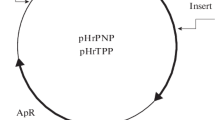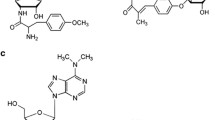Abstract
Thymidylate synthetase mutants of Xanthomonas maltophilia ATCC 13270 were isolated on a solid minimal medium containing 50 mg/l thymidine and a high concentration of trimethoprim (500 mg/l). It was found that a high concentration of trimethoprim was required to prevent background growth of the wild-type strain. The isolated mutants could grow on thymidine or dTMP at a concentration of 50 mg/l while they were unable to grow on 1000 mg/l thymine or 50 mg/l deoxyridine. Thymidylate synthetase activity was assayed in the wild-type cells and in the mutant cells but only the wild-type cells contained measurable enzyme activity.
Similar content being viewed by others
References
Bradford MM (1976) A rapid and sensitive method for the quantitation of microgram quantities of protein utilizing the principle of dye-binding. Anal Biochem 72:248–254
Espejo RT, Canelo ES, Sinsheimer RL (1971) Replication of bacteriophage PM2 deoxyribonucleic acid: a closed circular doublestranded molecule. J Mol Biol 56:597–621
Kelln RA, Warren RAJ (1973) Obligate thymidine auxotrophs of Pseudomonas acidovorans. J Bacteriol 113:510–511
Kelln RA, Warren RAJ (1974) Pyrimidine metabolism in Pseudomonas acidovorans. Can J Microbiol 20:427–433
Levenberg B, Hayaishi O (1959) A bacterial pterin deaminase. J Biol Chem 234:955–961
Munch-Petersen A (1968) On the catabolism of deoxyribonucleosides in cells and cell extracts of Escherichia coli. Eur J Biochem 6:432–442
O'Donovan GA (1978) Thymidine metabolism in bacteria (and “how or how not, to label DNA”). In: Molineux I, Kohiyama M (eds) DNA synthesis: present and future. Plenum Press, New York, pp 219–253
Potter AA, Musgrave DR, Loutit JS (1982) Thymine metabolism in Pseudomonas aeruginosa strain 1: the presence of a salvage pathway. J Gen Microbiol 128:1391–1400
Schwan H, Holldorf AW (1975) Effective utilization of exogenous deoxythymidine-5′-monophosphate for DNA synthesis in enterobacteria. FEBS Lett 57:179–182
Stanier RY (1947) Simultaneous adaption: a new technique for the study of metabolic pathways. J Bacteriol 54:339–348
Stanier RY, Palleroni NJ, Doudoroff M (1966) The aerobic pseudomonads: a taxonomic study. J Gen Microbiol 42:159–271
Wahba AJ, Friedkin M (1962) The enzymatic synthesis of thymidylate. I. Early steps in the purification of thymidylate synthetase of Escherichia coli. J Biol Chem 237:3794–3801
Watson JM, Holloway BW (1976) Suppressor mutations in Pseudomonas aeruginosa. J Bacteriol 125:780–786
West TP, Herlick SA, O'Donovan GA (1983) Inverse relationship between thymidylate synthetase and cytidine triphosphate synthetase activities during pyrimidine limitation in Salmonella typhimurium. FEMS Microbiol Lett 18:275–278
Author information
Authors and Affiliations
Rights and permissions
About this article
Cite this article
West, T.P. Isolation and characterization of thymidylate synthetase mutants of Xanthomonas maltophilia . Arch. Microbiol. 151, 220–222 (1989). https://doi.org/10.1007/BF00413133
Received:
Accepted:
Issue Date:
DOI: https://doi.org/10.1007/BF00413133




